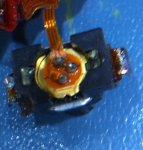jcranmer
0
- Joined
- Mar 23, 2011
- Messages
- 2,095
- Points
- 63
So here's the deal, like most of the new people here, I starting digging though my junk pile of dead computer parts for something useful. I found an optical drive, the problem is this thing was in rough condition and didn't have the faceplate on it any longer. I *thought* it was an old DVD burner, but it could very well have only been a CD burner. (If that's the case, that may be why I'm confused) If it's a DVD burner, I have no idea what the speed was, as I'm not even sure how old it was.
Anyway, after the tear down, I was surprised when the only thing I found is what I assume is a black plastic diode. It looks about right, except it's black plastic. The attached pics almost make it look like there is a metal can inside all that plastic, but I don't think that is the case, since there is a lens or filter that appears to be directly attached to the end of the plastic "can".
Anyway any help would be appreciated. And if this has been posted somewhere else and I actually missed it, feel free to call me a bonehead. It's OK as I have pretty thick skin. (I really did search for it first though! )
(I really did search for it first though! )


Anyway, after the tear down, I was surprised when the only thing I found is what I assume is a black plastic diode. It looks about right, except it's black plastic. The attached pics almost make it look like there is a metal can inside all that plastic, but I don't think that is the case, since there is a lens or filter that appears to be directly attached to the end of the plastic "can".
Anyway any help would be appreciated. And if this has been posted somewhere else and I actually missed it, feel free to call me a bonehead. It's OK as I have pretty thick skin.









